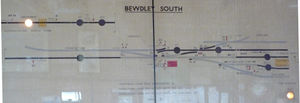Track Circuit
Track circuits are a system of train detection that relies upon the two rails forming a pair of electrical conductors along a designated section of railway. A power source (often a battery) is provided at one end and an electrical detector (often a relay) is provided at the other end. When the section of track is unoccupied the detector is energised. When the section of track becomes occupied by a train the wheels and axles short circuit the power source hence de-energising the detector, indicating the presence of a train. In order to increase safety, track circuits are often interlinked with the levers in a signal box, preventing a signalman from accidentally moving points underneath a train, or permitting two trains to be signalled towards each other.
A safety feature of track circuits is that they will show "occupied" in case of a broken rail, any conductive obstruction that touches both rails, or a failure of the power supply to the track circuit.
Track circuits on the SVRSevern Valley Railway
Track circuits are installed at a number of stations on the SVRSevern Valley Railway, specifically Bridgnorth, Arley, Bewdley, and Kidderminster. Additionally, there is continuous track circuiting between Bewdley South signal box and Kidderminster, allowing the section to be operated by Acceptance Lever.
Track-circuit operating clips
A piece of safety equipment is a track-circuit operating clip, a length of wire connecting two metal spring clips that clip onto a rail. In the event of accident or obstruction a clip is applied to both rails to indicate that that line is occupied, putting the signal for that section to danger.
Links
- Track circuits explained, Network Rail, 30 September 2019 (Retrieved 24 October 2019)
- Track circuits on Wikipedia
